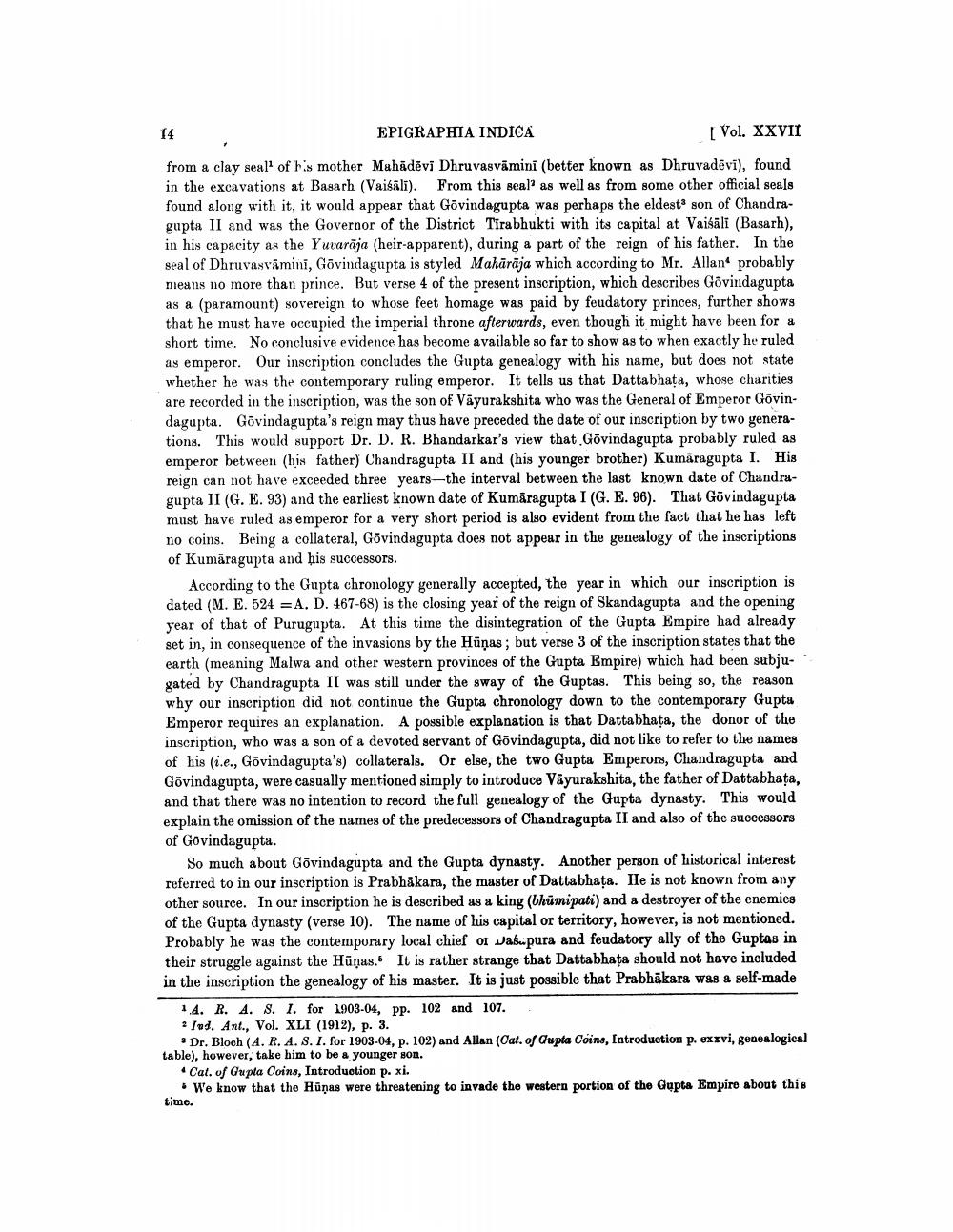________________
EPIGRAPHIA INDICA
[ Vol. XXVII
from a clay seal of his mother Mahādēvi Dhruvasvāmini (better known as Dhruvadēvi), found in the excavations at Basarh (Vaisāli). From this seal as well as from some other official seals found along with it, it would appear that Govindagupta was perhaps the eldest son of Chandragupta II and was the Governor of the District Tirabhukti with its capital at Vaisali (Basarh), in his capacity as the Yuvarāja (heir apparent), during a part of the reign of his father. In the seal of Dhruvanvåmini, Govindagupta is styled Mahārāja which according to Mr. Allan' probably means no more than prince. But verse 4 of the present inscription, which describes Govindagupta as a (paramount) sovereign to whose feet homage was paid by feudatory princes, further shows that he must have occupied the imperial throne afterwards, even though it might have been for a short time. No conclusive evidence has become available so far to show as to when exactly he ruled ay emperor. Our inscription concludes the Gupta genealogy with his name, but does not state whether he was the contemporary ruling emperor. It tells us that Dattabhata, whose charities are recorded in the inscription, was the son of Vāyurakshita who was the General of Emperor Govindagupta. Govindagupta's reign may thus have preceded the date of our inscription by two generations. This would support Dr. D. R. Bhandarkar's view that Govindagupta probably ruled as emperor between his father) Chandragupta II and (his younger brother) Kumāragupta I. His reign can not have exceeded three years--the interval between the last known date of Chandragupta II (G. E. 93) and the earliest known date of Kumāragupta I (G. E. 96). That Govindagupta must have ruled as emperor for a very short period is also evident from the fact that he has left no coins. Being a collateral, Govindagupta does not appear in the genealogy of the inscriptions of Kumāragupta and his successors.
According to the Gupta chronology generally accepted, the year in which our inscription is dated (M. E. 524 =A. D. 467-68) is the closing year of the reign of Skandagupta and the opening year of that of Purugupta. At this time the disintegration of the Gupta Empire had already set in, in consequence of the invasions by the Hūnas; but verse 3 of the inscription states that the earth (meaning Malwa and other western provinces of the Gupta Empire) which had been subjugated by Chandragupta II was still under the sway of the Guptas. This being so, the reason why our inscription did not continue the Gupta chronology down to the contemporary Gupta Emperor requires an explanation. A possible explanation is that Dattabhata, the donor of the inscription, who was a son of a devoted servant of Govindagupta, did not like to refer to the names of his (i.e., Govindagupta's) collaterals. Or else, the two Gupta Emperors, Chandragupta and Govindagupta, were casually mentioned simply to introduce Väyurakshita, the father of Dattabhata, and that there was no intention to record the full genealogy of the Gupta dynasty. This would explain the omission of the names of the predecessors of Chandragupta II and also of the successors of Govindagupta.
So much about Govindagupta and the Gupta dynasty. Another person of historical interest referred to in our inscription is Prabhākara, the master of Dattabhata. He is not known from any other source. In our inscription he is described as a king (bhumipati) and a destroyer of the enemics of the Gupta dynasty (verse 10). The name of his capital or territory, however, is not mentioned. Probably he was the contemporary local chief or Jaśc.pura and feudatory ally of the Guptas in their struggle against the Hūnas. It is rather strange that Dattabhata should not have included in the inscription the genealogy of his master. It is just possible that Prabhākara was a self-made
1.4. R. A. 8. I. for 1903-04, pp. 102 and 107. 2 Ind. Ant., Vol. XLI (1912), p. 3.
Dr. Bloch (A. R.A.S. I. for 1903-04, p. 102) and Allan (Cat. of Gupta Coins, Introduction p. exxvi, genealogical table), however, take him to be a younger son.
Cat. of Gupta Coins, Introduction p. xi. • We know that the Hūņas were threatening to invade the western portion of the Gupta Empire about this time.




